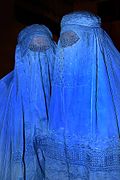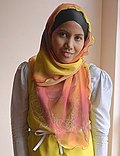Fashionable Hindu Hijab Khimar Emerald Green and Blue
This table of types of hijab describes terminologically distinguished styles of Islamic clothing usually associated with the word hijab.
The Arabic word hijāb can exist translated as "cover, wrap, drapery, veil, screen, partitioning", among other meanings.[ane] In the Quran it refers to notions of separation, protection and covering in both literal and metaphorical senses.[ii] Later on, the give-and-take has evolved in meaning and now usually denotes a Muslim woman's veil or the notion of separation betwixt the sexes.[two] In English, the term refers predominantly to the Islamic caput covering for women and its underlying religious precepts.[3] [4]
| Proper noun | Image | Description |
|---|---|---|
| Abaya عباية |  | Total-length, robe-similar outer garment that covers the whole torso except the caput, feet, and hands. Usually worn with a headscarf or (especially in Saudi Arabia) gloves and niqab. |
| al-Amira |  | A ii-slice veil. It consists of a close plumbing equipment cap, usually fabricated from cotton or polyester, and an accompanying tube-like scarf. |
| Bushiyya |  | A veil that is tied on at the brow and falls to cover the entire face but has no cut-out for the eyes; instead, the material is sheer plenty to be seen through (Centre East, specifically Farsi Gulf). |
| Bukhnuq بخنق |  | This is similar to khimār ii (see beneath) but comes down just to the bosom. Sometimes called "Amira hijab" if it has embroidery at the edge. |
| Eastern Arabia Batula برقع شرق الجزيرة العربية |  | Women wear information technology in United Arab Emirates, Oman, Qatar and Arabs of Southern Islamic republic of iran. This tradition has well-nigh died out in the newer generations. Older women past 50, and those living in rural areas tin can however be seen wearing them. |
| Burqa or Chadari Bengali (give-and-take used to wearable in Grozny, Chechnya, and Uzbekistan, transferred to Afghanistan) برقع، چادری |  | Traditional Central Asian[v] manner outer garment that covers the entire trunk and has a grille over the face that the adult female looks through. Very like in manner and function to other Central Asian styles such every bit the paranja Burqa or Chadari Bengali word used to vesture in Grozny Chechnya and Uzbekistan transferred to Afghanistan past Salafi'southward. |
| Chador |  | An Iranian traditional outer garment (also worn in other countries) that covers the head and body and is a full-length semicircle of textile merely comes downwardly to the ground. Does non take slits for the hands and is held shut with the easily, teeth or only wrapped under the arms. |
| Elechek |  | White turban traditionally worn by Kyrgyz women, currently reserved for special occasions.[six] [7] |
| Hijāb حجاب | May refer to whatsoever head covering. See Hijab | |
| Jilbāb (1) جلباب | generic | The term used in the Qur'an (Suratu l-Ahzāb, āya 59) to refer to the outer garment. In Indonesia, the term jilbab refers exclusively to the caput-covering. |
| Jilbāb (two) |  | A type of outer garment that looks similar a long raincoat or trenchcoat. |
| Kalpak |  | Traditional headgear of single woman in Republic of kazakhstan, Karakalpakstan and Kyrgyzstan. |
| Kalfak (ru:Калфак, tt:Калфак) |  | Traditional headgear of Tatars woman. |
| Kelaghayi |  | A traditional Azerbaijani women's headgear. |
| Kerudung |  | Although similar to the Malaysian tudong (below), the modern Indonesian kerudung usually includes a strong visor higher up the optics. |
| Khimār (1) خمار | generic | The term used in the Qur'an (Suratu northward-Nūr, āya 31) to refer to the headscarf; the discussion "hijāb" is more usually used with this meaning. |
| Khimār (two) | Most unremarkably, a circular head covering with a hole cut out for the face, which unremarkably comes down to the waist. Note the variations bukhnuq and chador in a higher place, which are the aforementioned fashion only different lengths. | |
| Kimeshek (kk:Кимешек) |  | Traditional headgear of married woman in Kazakhstan, Karakalpakstan and Kyrgyzstan. |
| Kurhars (ru:Курхарс) |  | Traditional headgear of single woman in Ingushetia. |
| Mukena |  | An Indonesian hijab worn virtually exclusively for praying. It is attached around the caput with two strings. Colours are normally white or pastel. |
| Niqaab نقاب |  | A veil that covers the face and unabridged caput but with a place cut out for the eyes (image: mode worn in Yemen). |
| Niqaab (2) |  | A veil that is tied on at the bridge of the olfactory organ and falls to comprehend the lower face up. Likewise called "half niqab". |
| Oramal (kk:Орамал) |  | A traditional kerchief used in Primal Asia and the Caucasus (notation how it is banded, the neck is usually non covered by it). In some countries similar Uzbekistan it was traditionally used only at dwelling, while in public the paranja was more popular. In other countries, like Kazakhstan, it was unremarkably used in public. In Kyrgyzstan, the white color is an indication that the woman is married. |
| Paranja |  | A Primal Asian traditional outer garment that covers the head and trunk, heavy in weight and made from horsehair. Once prevalent in Uzbek and Tajik societies. |
| Selendang |  | In Southeast Asia, a multi-purpose shoulder sash that can exist tied around the shoulders to carry infants and groceries, or draped over the caput. |
| Shayla |  | Long, rectangular scarf, wrapped around the head and tucked or pinned in place at the shoulders. Popular in Arab states of the Persian Gulf.[eight] |
| Taqiyah (cap) |  |
|
| Tudung or Kerudung |  | Headscarf worn in Malaysia and Indonesia. In Indonesia, the term kerudung is much more than common. |
| Türban |  | Turkish term for a headscarf pinned neatly at the sides.[nine] |
See as well [edit]
- Islam and clothing
References [edit]
- ^ El Guindi, Fadwa; Sherifa Zahur (2009). Hijab. The Oxford Encyclopedia of the Islamic World. doi:10.1093/acref/9780195305135.001.0001. ISBN9780195305135.
- ^ a b Siddiqui, Mona (2006). "Veil". In Jane Dammen McAuliffe (ed.). Encyclopaedia of the Qurʾān. Brill.
- ^ Hijab in Merriam-Webster
- ^ Hijab at Oxford Dictionaries
- ^ Abu-Lughod, Lila (2002). "Do Muslim Women Really Need Saving? Anthropological Reflections on Cultural Relativism and Its Others". American Anthropologist. 104 (three): 783–790. doi:10.1525/aa.2002.104.3.783.
- ^ BBC Trending (xiii August 2016). "Kyrgyzstan president: 'Women in mini skirts don't get suicide bombers'". BBC.
- ^ Bradley Mayhew, Greg Blossom, Paul Clammer, Michael Kohn (2010). Primal Asia. Lone Planet. p. 63. ISBN9781741791488.
{{cite volume}}: CS1 maint: uses authors parameter (link) - ^ BBC, In graphics: Muslim veils
- ^ Rainsford, Sarah (November 7, 2006). "Headscarf issue challenges Turkey". BBC News.
External links [edit]
- BBC drawings depicting different forms of Islamic women's clothing
- List of [1] types

0 Response to "Fashionable Hindu Hijab Khimar Emerald Green and Blue"
Post a Comment